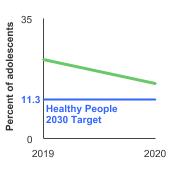On This Page:
- Background
- Measure
- Healthy People 2030 Target
- Data Source
- Trends and Most Recent Estimates
- Related Cancers
- Additional Information
Background
Cigarette smoking is the leading preventable cause of disease, disability, and death in the United States. Smoking causes cancers of the lung, esophagus, larynx (voice box), mouth, throat, kidney, bladder, liver, pancreas, stomach, cervix, colon and rectum, as well as acute myeloid leukemia. Tobacco use is initiated and established primarily during adolescence (defined as ages 10-19): nearly 90 percent of adults in the U.S. who smoke daily first tried cigarettes by age 18, and 98 percent first tried cigarettes by age 26. Each day in the U.S., around 1,500 youth aged 17 or younger smoke their first cigarette.
Electronic cigarettes (e-cigarettes, also known as vapes or Electronic Nicotine Delivery Systems [ENDS]) are battery-powered devices that convert a liquid (“e-liquid”) into an aerosol. E-liquids typically contain nicotine, flavorings, vegetable glycerin, propylene glycol, and other chemicals. In addition to nicotine, e-cigarette aerosol may contain heavy metals, volatile organic compounds, and fine and ultrafine particles that can be inhaled deeply into the lungs by both users and bystanders. Nicotine use among youth increases the risk of lifelong tobacco addiction and may also increase the risk for future addiction to other drugs.
Youth cigarette smoking prevalence peaked around 1996/1997 but has been declining since. However, a substantial portion of youth use other tobacco products, including e-cigarettes, cigars, smokeless tobacco, and hookah/waterpipe. According to data from the 2023 National Youth Tobacco Survey (NYTS), 2.80 million (10.0%) middle and high school students reported current use of a tobacco product. Youth use of more than one tobacco product (dual use) is also common. Since 2014, e-cigarettes have been the most commonly used tobacco product among youth, and, in 2018, former U.S. Surgeon General Jerome Adams issued an advisory declaring youth e-cigarette use an epidemic.
According to data from the NYTS, in 2023, more than 2.13 million U.S. youth, including 10.0% of high school students and 4.6% of middle school students, currently used e-cigarettes. Moreover, among high school students who reported current e-cigarette use, 39.7% reported using the products frequently (on 20 or more of the past 30 days) and 29.2% reported daily use. Flavors are an important aspect of appeal to middle and high school students who use e-cigarettes, with 89.4% reporting having used flavored e-cigarettes (e.g., fruit, candy, menthol flavors).
There are many factors associated with youth tobacco use, including social, environmental, cognitive, and genetic influences. In addition, Preventing Tobacco Use Among Youth and Young Adults: A Report of the Surgeon General, published by the Centers for Disease Control and Prevention in 2012, concluded that tobacco advertising, promotion, and depictions of smoking in movies are causally related to youth tobacco use. Initiation of smoking during adolescence is linked to persistent smoking during adult life and the many adverse health effects caused by smoking.
Understanding trends in youth initiation and use of tobacco products – including cigarettes, e-cigarettes, cigars, and smokeless tobacco – helps policy makers determine how to allocate prevention resources. Effective strategies to reduce youth initiation of tobacco use include federal regulation of tobacco products; significant increases in tobacco prices, including excise taxes; smokefree air laws; restrictions on tobacco advertising and promotion; restricting the availability of tobacco products to youth; mass-media public education campaigns; and full implementation of comprehensive state and community tobacco control programs. On December 20, 2019, legislation was enacted to amend the Federal Food, Drug, and Cosmetic Act, and raise the federal minimum age of sale of tobacco products from 18 to 21 years.
Measure
The percentage of middle and high school students (grades 6–12) who reported use of cigarettes, cigars, smokeless tobacco, or e-cigarettes on at least 1 day during the 30 days before the survey.
The percentage of middle and high school students who reported use of any tobacco product (cigarettes, e-cigarettes, cigars, smokeless tobacco—including chewing tobacco, snuff, dip—hookah, pipe tobacco, bidis, dissolvable tobacco, or snus) on at least 1 day during the 30 days before the survey.
Data Source
Centers for Disease Control and Prevention, National Youth Tobacco Survey (NYTS), 2019-2021.1, 2
1 Between 1999 and 2018, the NYTS was conducted using paper-and-pencil questionnaires. In 2019, the mode of administration changed to an electronic survey, making prior years’ estimates incomparable. This Report focuses on data from 2019 and later.
2 Because NYTS is administered in schools, to accommodate students learning under varying instructional models (in-person, distance/virtual, and hybrid), the 2021 NYTS was administered using a web URL. Approximately half of respondents reported completing the survey at school or in the classroom, and half reported completing the survey at home or some other place. Prevalence estimates from 2021 should be interpreted with caution, as the proportion of students reporting any tobacco use differed greatly between those who completed the survey at school vs. at another location.
Healthy People 2030 Target
- Reduce to 11.3 percent the proportion of adolescents in grades 6–12 who used tobacco products (cigarettes, e-cigarettes, cigars, smokeless tobacco, hookah, pipe tobacco, and/or bidis) in the past 30 days.
- Reduce to 10.5 percent the proportion of adolescents in grades 6-12 who used e-cigarettes in the past 30 days.
- Reduce to 3.4 percent the proportion of adolescents in grades 6–12 who smoked cigarettes in the past 30 days.
- Reduce to 3 percent the proportion of adolescents in grades 6–12 who smoked cigars in the past 30 days.
- Reduce to 2.3 percent the proportion of adolescents in grades 6–12 who used smokeless tobacco products (chewing tobacco or snuff) in the past 30 days.
Healthy People 2030 is a set of goals set forth by the Department of Health and Human Services.
Note: Goals are indicated as blue line on Detailed Trend Graphs.
Trends and Most Recent Estimates
By Type of Tobacco Product
| Overview Graph | Detailed Trend Graphs | Most Recent Estimates (2020) | |
|---|---|---|---|
| Percent of adolescents | 95% Confidence Interval | ||
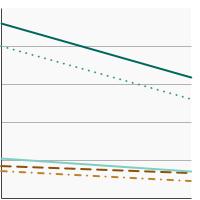  |
All Tobacco |
15.9 | 13.9 - 18.1 |
Cigarettes |
3.3 | 2.6 - 4.2 | |
E-Cigarettes |
13.1 | 11.2 - 15.1 | |
Smokeless Tobacco |
2.3 | 1.8 - 3.0 | |
Cigars |
3.5 | 2.9 - 4.3 | |
All Tobacco Products
By Sex
| Overview Graph | Detailed Trend Graphs | Most Recent Estimates (2020) | |
|---|---|---|---|
| Percent of adolescents | 95% Confidence Interval | ||
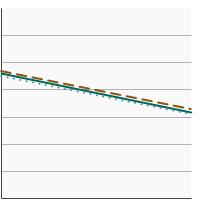  |
Both Sexes |
15.9 | 13.9 - 18.1 |
Male |
16.3 | 14.1 - 18.8 | |
Female |
15.6 | 13.5 - 17.9 | |
By Race/Ethnicity
| Overview Graph | Detailed Trend Graphs | Most Recent Estimates (2020) | |
|---|---|---|---|
| Percent of adolescents | 95% Confidence Interval | ||
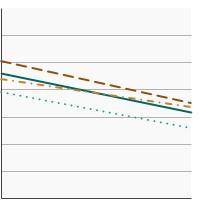  |
All Races/Ethnicities |
15.9 | 13.9 - 18.1 |
Non-Hispanic White |
17.5 | 15.1 - 20.3 | |
Non-Hispanic Black |
12.9 | 10.9 - 15.2 | |
Hispanic |
16.7 | 14.0 - 19.8 | |
By Current Grade Level
| Overview Graph | Detailed Trend Graphs | Most Recent Estimates (2020) | |
|---|---|---|---|
| Percent of adolescents | 95% Confidence Interval | ||
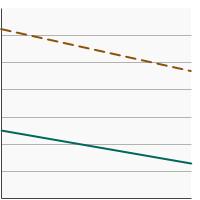  |
Middle School |
6.4 | 5.2 - 7.8 |
High School |
23.3 | 20.8 - 26.0 | |
Cigarettes
By Sex
| Overview Graph | Detailed Trend Graphs | Most Recent Estimates (2020) | |
|---|---|---|---|
| Percent of adolescents | 95% Confidence Interval | ||
  |
Both Sexes |
3.3 | 2.6 - 4.2 |
Male |
3.6 | 2.7 - 4.7 | |
Female |
3.1 | 2.4 - 4.0 | |
By Race/Ethnicity
| Overview Graph | Detailed Trend Graphs | Most Recent Estimates (2020) | |
|---|---|---|---|
| Percent of adolescents | 95% Confidence Interval | ||
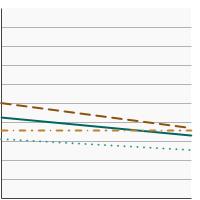  |
All Races/Ethnicities |
3.3 | 2.6 - 4.2 |
Non-Hispanic White |
3.7 | 2.8 - 4.8 | |
Non-Hispanic Black |
2.5 | 1.7 - 3.7 | |
Hispanic |
3.6 | 2.6 - 4.9 | |
By Current Grade Level
| Overview Graph | Detailed Trend Graphs | Most Recent Estimates (2020) | |
|---|---|---|---|
| Percent of adolescents | 95% Confidence Interval | ||
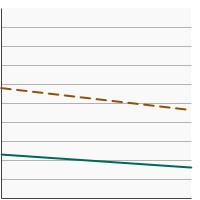  |
Middle School |
1.6 | 1.2 - 2.3 |
High School |
4.6 | 3.6 - 6.0 | |
E-Cigarettes
By Sex
| Overview Graph | Detailed Trend Graphs | Most Recent Estimates (2020) | |
|---|---|---|---|
| Percent of adolescents | 95% Confidence Interval | ||
  |
Both Sexes |
13.1 | 11.2 - 15.1 |
Male |
13.4 | 11.5 - 15.6 | |
Female |
12.8 | 10.8 - 15.0 | |
By Race/Ethnicity
| Overview Graph | Detailed Trend Graphs | Most Recent Estimates (2020) | |
|---|---|---|---|
| Percent of adolescents | 95% Confidence Interval | ||
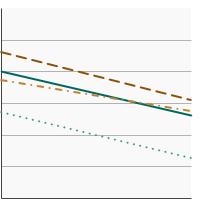  |
All Races/Ethnicities |
13.1 | 11.2 - 15.1 |
Non-Hispanic White |
15.5 | 13.4 - 17.9 | |
Non-Hispanic Black |
6.2 | 4.6 - 8.4 | |
Hispanic |
13.7 | 11.1 - 16.8 | |
By Current Grade Level
| Overview Graph | Detailed Trend Graphs | Most Recent Estimates (2020) | |
|---|---|---|---|
| Percent of adolescents | 95% Confidence Interval | ||
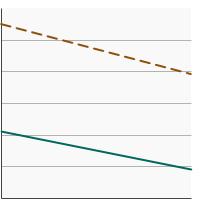  |
Middle School |
4.7 | 3.6 - 6.0 |
High School |
19.6 | 17.2 - 22.2 | |
Smokeless Tobacco
By Sex
| Overview Graph | Detailed Trend Graphs | Most Recent Estimates (2020) | |
|---|---|---|---|
| Percent of adolescents | 95% Confidence Interval | ||
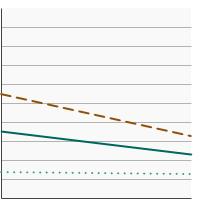  |
Both Sexes |
2.3 | 1.8 - 3.0 |
Male |
3.3 | 2.5 - 4.4 | |
Female |
1.3 | 0.9 - 1.7 | |
By Race/Ethnicity
| Overview Graph | Detailed Trend Graphs | Most Recent Estimates (2020) | |
|---|---|---|---|
| Percent of adolescents | 95% Confidence Interval | ||
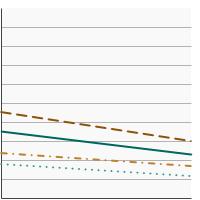  |
All Races/Ethnicities |
2.3 | 1.8 - 3.0 |
Non-Hispanic White |
3.0 | 2.3 - 4.0 | |
Non-Hispanic Black |
1.2 | 0.6 - 2.3 | |
Hispanic |
1.7 | 1.3 - 2.2 | |
By Current Grade Level
| Overview Graph | Detailed Trend Graphs | Most Recent Estimates (2020) | |
|---|---|---|---|
| Percent of adolescents | 95% Confidence Interval | ||
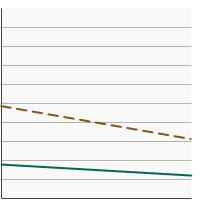  |
Middle School |
1.2 | 0.9 - 1.7 |
High School |
3.1 | 2.3 - 4.2 | |
Cigars
By Sex
| Overview Graph | Detailed Trend Graphs | Most Recent Estimates (2020) | |
|---|---|---|---|
| Percent of adolescents | 95% Confidence Interval | ||
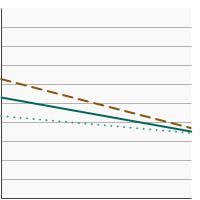  |
Both Sexes |
3.5 | 2.9 - 4.3 |
Male |
3.7 | 3.0 - 4.5 | |
Female |
3.4 | 2.7 - 4.4 | |
By Race/Ethnicity
| Overview Graph | Detailed Trend Graphs | Most Recent Estimates (2020) | |
|---|---|---|---|
| Percent of adolescents | 95% Confidence Interval | ||
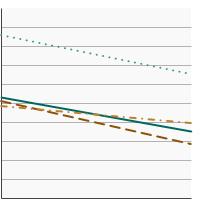  |
All Races/Ethnicities |
3.5 | 2.9 - 4.3 |
Non-Hispanic White |
2.8 | 2.1 - 3.7 | |
Non-Hispanic Black |
6.6 | 5.3 - 8.1 | |
Hispanic |
4.0 | 2.9 - 5.4 | |
By Current Grade Level
| Overview Graph | Detailed Trend Graphs | Most Recent Estimates (2020) | |
|---|---|---|---|
| Percent of adolescents | 95% Confidence Interval | ||
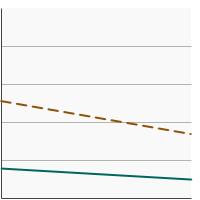  |
Middle School |
1.5 | 1.1 - 2.0 |
High School |
5.0 | 4.1 - 6.2 | |
Previous Trends, 2011-2018
| Overview Graph | Detailed Trend Graphs | Most Recent Estimates (2018) | |
|---|---|---|---|
| Percent of adolescents | 95% Confidence Interval | ||
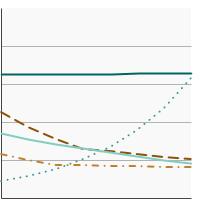  |
All Tobacco |
18.3 | 16.9 - 19.9 |
Cigarettes |
5.4 | 4.6 - 6.2 | |
E-Cigarettes |
13.8 | 12.4 - 15.3 | |
Smokeless Tobacco |
4.1 | 3.5 - 4.9 | |
Cigars |
5.0 | 4.4 - 5.7 | |
Additional Information
- Tobacco. National Cancer Institute.
- Tobacco and Cancer. American Cancer Society.
- 2016 Surgeon General’s Report—E-cigarette Use Among Youth and Young Adults. Centers for Disease Control and Prevention.
- 2018 Surgeon General’s Advisory on E-cigarette Use Among Youth. Office of the U.S. Surgeon General and Centers for Disease Control and Prevention.
- 50 Years of Progress: A Report of the Surgeon General, 2014. U.S. Department of Health and Human Services.
- Quick Facts on the Risks of E-Cigarette’s for Kids, Teens, and Young Adults. Centers for Disease Control and Prevention.
- Youth Tobacco Prevention. Centers for Disease Control and Prevention.
- Youth and Tobacco. U.S. Food and Drug Administration.
Quitting Resources
- Smokefreeteen.gov. National Cancer Institute.
- SmokefreeTXT. National Cancer Institute.
- Cigarette Smoking: Health Risks and How to Quit (PDQ®)–Patient Version. National Cancer Institute.
- Smokefree.gov. National Cancer Institute.
- Where To Get Help When You Decide To Quit Smoking. National Cancer Institute.
- How to Quit Smoking or Smokeless Tobacco. American Cancer Society.
- Cigarette Smoking: Health Risks and How to Quit (PDQ®)–Health Professional Version. National Cancer Institute.
- Tobacco Control Evidence-Based Programs Listing. National Cancer Institute.
- Julius B. Richmond Center. American Academy of Pediatrics.
- Best Practices for Comprehensive Tobacco Control Programs—2014. Centers for Disease Control and Prevention.
- Best Practices: Putting Evidence into Practice. Centers for Disease Control and Prevention.
- Healthcare Provider Resources: Smoking and Tobacco Use. Centers for Disease Control and Prevention.
- Tobacco 21. U.S. Food and Drug Administration.
- Monograph 19: The Role of the Media in Promoting and Reducing Tobacco Use.. National Cancer Institute. Smoking and Tobacco Control Monographs.
- Tobacco Use in Top-Grossing Movies-United States, 2010-2018. Centers for Disease Control and Prevention. MMWR. 2019; 68(43):974-978.
- Tobacco Product Use Among U.S. Middle and High School Students — National Youth Tobacco Survey, 2023. Birdsey J, Cornelius M, Jamal A, et al. MMWR. 2023; 72:1173–1182.
- Tobacco Product Use Among High School Students — Youth Risk Behavior Survey, United States, 2019. Creamer MR, Everett Jones S, Gentzke AS, et al. MMWR Suppl. 2020;69(Suppl-1):56–63.
- Notes from the Field: Use of Electronic Cigarettes and Any Tobacco Product Among Middle and High School Students — United States, 2011–2018.. Cullen KA, Ambrose BK, Gentzke AS et al. MMWR. 2018;67(45):1276-1277.
- Vital Signs: Tobacco Product Use Among Middle and High School Students – United States, 2011-2018. Gentzke AS, Creamer M, Cullen KA, et al. MMWR. 2019; 68(6):157-164.
- Monitoring the Future: national survey results on drug use, 1975–2017: Overview, key findings on adolescent drug use. Johnston LD, Miech RA, O'Malley PM, et al. The University of Michigan, Institute for Social Research, 2018.
- Notes from the Field: E-cigarette Use Among Middle and High School Students — United States, 2022. Cooper M, Park-Lee E, Ren C, et al. MMWR. 2022; 71(40);1283–1285.
